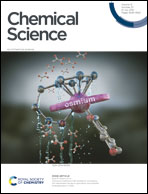Atroposelective synthesis of N-aryl peptoid atropisomers via a palladium(ii)-catalyzed asymmetric C–H alkynylation strategy†‡
Abstract
The introduction of chirality into peptoids is an important strategy to determine a discrete and robust secondary structure. However, the lack of an efficient strategy for the synthesis of structurally diverse chiral peptoids has hampered the studies. Herein, we report the efficient synthesis of a wide variety of N-aryl peptoid atropisomers in good yields with excellent enantioselectivities (up to 99% yield and 99% ee) by palladium-catalyzed asymmetric C–H alkynylation. The inexpensive and commercially available L-pyroglutamic acid was used as an efficient chiral ligand. The exceptional compatibility of the C–H alkynylation with various peptoid oligomers renders this procedure valuable for peptoid modifications. Computational studies suggested that the amino acid ligand distortion controls the enantioselectivity in the Pd/L-pGlu-catalyzed C–H bond activation step.



 Please wait while we load your content...
Please wait while we load your content...